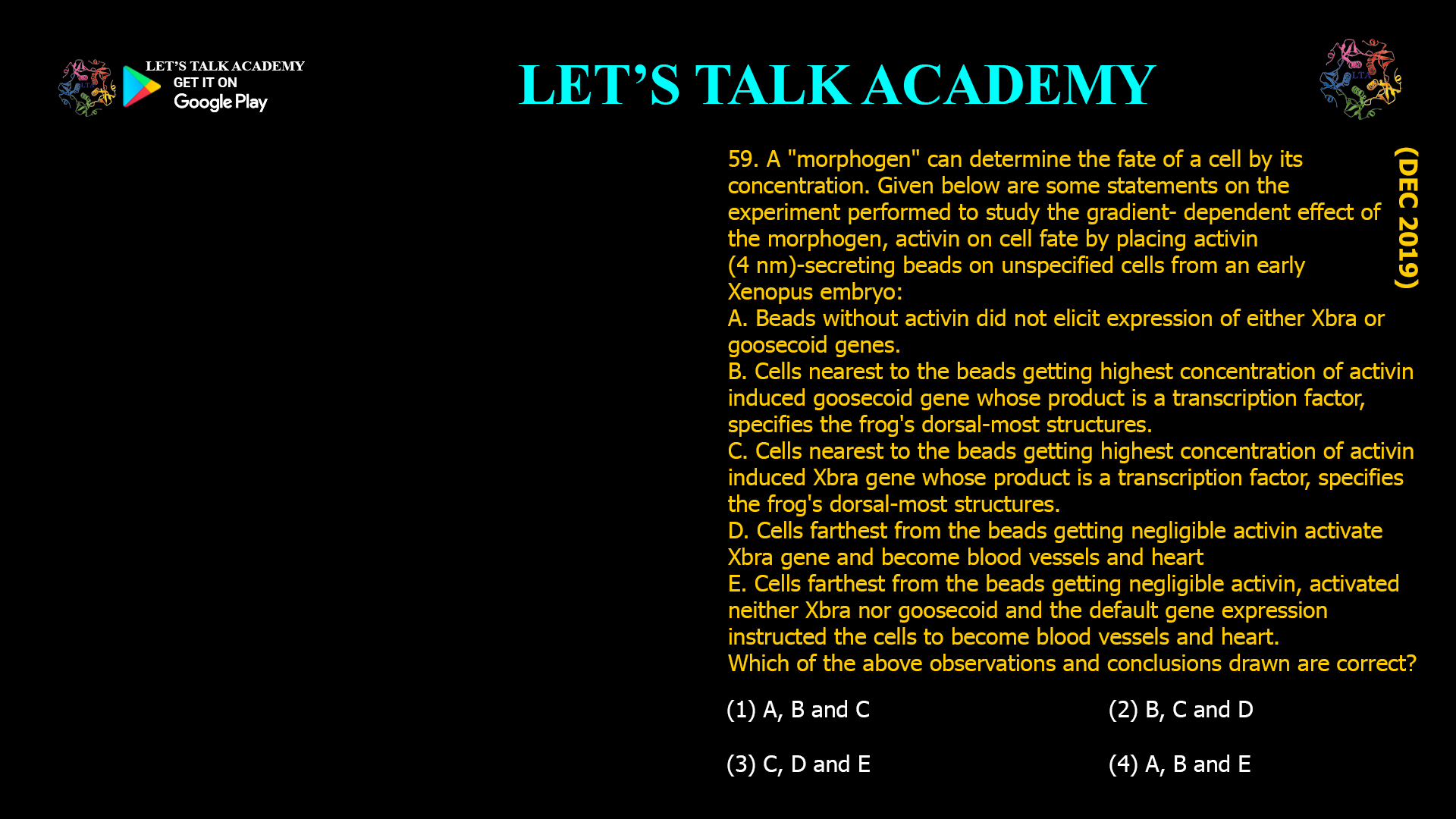59. A “morphogen” can determine the fate of a cell by its concentration. Given below are some statements on the experiment performed to study the gradient- dependent effect of the
morphogen, activin on cell fate by placing activin (4 nm)-secreting beads on unspecified cells from an early Xenopus embryo:
A. Beads without activin did not elicit expression of either Xbra or goosecoid genes.
B. Cells nearest to the beads getting highest concentration of activin induced goosecoid gene
whose product is a transcription factor, specifies the frog’s dorsal-most structures.
C. Cells nearest to the beads getting highest concentration of activin induced Xbra gene whose
product is a transcription factor, specifies the frog’s dorsal-most structures.
D. Cells farthest from the beads getting negligible activin activate Xbra gene and become blood vessels and heart
E. Cells farthest from the beads getting negligible activin, activated neither Xbra nor goosecoid and the default gene expression instructed the cells to become blood vessels and heart.
Which of the above observations and conclusions drawn are correct?
(1) A, B and C (2) B, C and D
(3) C, D and E (4) A, B and E
Among the observations regarding the activin gradient experiment on early Xenopus embryos with activin (4 nM)-secreting beads:
-
A is correct: Beads without activin do not induce expression of Xbra or goosecoid genes.
-
B is correct: Cells closest to the bead getting the highest activin concentration induce goosecoid, a transcription factor specifying dorsal-most structures (organizer).
-
E is correct: Cells farthest from the beads, receiving negligible activin, do not activate Xbra or goosecoid and follow the default pathway to become blood vessels and heart.
Statements C and D are not supported because Xbra is induced by intermediate, not highest, activin concentrations and specifies more ventrolateral mesodermal fates, not dorsal-most structures, while blood vessels and heart arise from cells with little or no activin, activating neither gene.
Thus, the correct option is (4) A, B, and E.
Introduction
Activation of different gene programs in response to morphogen concentration gradients is fundamental in embryonic patterning. Activin, a TGF-β family morphogen in Xenopus embryos, differentially induces key regulatory genes Xbra and goosecoid according to concentration. This gradient-dependent activation directs mesodermal cell fate in a spatially organized manner.
Morphogen Gradient Concept and Activin in Xenopus
-
Morphogens diffuse from localized sources to form concentration gradients, eliciting distinct cellular responses based on threshold levels.
-
In Xenopus, activin beads placed on unspecified embryonic cells create a gradient eliciting gene expression dependent on concentration.
Differential Gene Activation by Activin Concentration
-
Goosecoid expression is induced by high activin concentrations close to the bead; goosecoid is a transcription factor marking the organizer and dorsal-most mesoderm.
-
Xbra expression is activated by intermediate or lower concentrations and corresponds to more ventrolateral mesodermal fates.
-
At high activin levels, goosecoid can suppress Xbra, refining mesodermal patterning.
Default Fate of Cells with No or Negligible Activin
-
Cells farthest from the activin source receive minimal signaling, do not activate goosecoid or Xbra, and by default differentiate into ventral mesodermal derivatives like blood vessels and heart.
Experiment Findings Aligned with Statements
-
Beads without activin fail to induce either gene, confirming activin’s necessity (Statement A).
-
High concentrations induce goosecoid, specifying organizer and dorsal structures (Statement B).
-
Cells with negligible activin don’t express these genes and form blood and heart (Statement E).
-
Statement C is incorrect because goosecoid, not Xbra, marks dorsal-most structures.
-
Statement D is incorrect as blood vessels and heart arise from cells not activating Xbra but following default programs.
Summary Table: Activin Gradient Gene Activation and Cell Fate
| Gene | Activin Concentration Threshold | Cell Fate Specification |
|---|---|---|
| Goosecoid | High | Dorsal-most mesoderm, organizer structures |
| Xbra | Intermediate to low | Ventrolateral mesoderm, muscle & somites |
| Neither gene | Negligible | Ventral mesoderm derivatives: blood, heart |
Conclusion
The experiment confirms that activin acts as a morphogen inducing distinct gene expression and cell fates by concentration thresholds. Statements A, B, and E correctly describe the activin gradient effects, with high activin inducing dorsal structures via goosecoid, intermediate inducing Xbra, and absence leading to default ventral fates.
FAQ
Q: What cell fates does goosecoid specify?
Goosecoid specifies organizer and dorsal-most mesoderm structures.
Q: What does Xbra gene expression indicate?
Xbra specifies ventrolateral mesodermal derivatives such as muscle and somites.
Q: What happens to cells with no activin?
They default to ventral fates like blood vessels and heart.
This understanding of morphogen gradient-dependent gene activation in Xenopus provides crucial insights for developmental biology and embryogenesis examination preparation.



